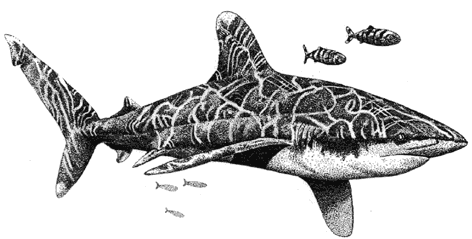Oceanic Whitetip Shark (Carcharhinus longimanus)

OTHER NAMES
Whitetip
HABITAT
Deep ocean only, but is occasionally encountered in areas where ocean depths closely approach island shores.
DESCRIPTION
White tips on the dorsal, pectoral and caudal fins. Even without the white (it's absent on a rare specimen) the high, rounded dorsal and long, rounded pectoral fins are giveaways.
SIZE
Up to 8-10 feet and 100-150 pounds. World record 146 pounds, 8 ounces.
OVERVIEW
This species is extremely dangerous and has been responsible for a number of human deaths. This is an entirely different shark from the small White-Tipped Reef Shark. The Oceanic is a large shark growing to about 350 cm. It is easy to recognise as it has very large, rounded dorsal and pectoral fins. These fins are mottled with white on the edges. This mottling may be absent on young sharks. In fact on unborn sharks the colour pattern is reversed and the shark has black tips to its fins. It is thought that this may also apply to newly born and very young sharks.
This shark has strong, wide triangular, serrated upper teeth, capable of doing a lot of damage. The Oceanic Whitetip is found around most of the world except very cold areas. It prefers water above 20 degrees celsius, but has been found in temperatures ranging from 18 - 28 degrees celsius. It is mainly pelagic, preferring the deep, open water and rarely comes into shore. It is often found in similar areas to the Blue Shark. They have however been noted in water as shallow as 37 metres and as deep as 184 metres.
The Oceanic Whitetip is thought to be responsible for many of the fatal attacks on plane and shipwreck survivors at sea. It is not often seen in shallow water. It is considered one of the top four most dangerous sharks to humans and it has been known to bite for no reason. It might be moving along quite calmly and for no known reason lunge out and attack. This means its behaviour is unpredictable and that alone makes it very dangerous. The fact that they are normally not alone also adds a dangerous aspect.
These sharks are often found anywhere there are dead whales. They are also well known for following pods of Pilot Whales and schools of large fish such as Tuna. There are many accounts of people seeing Dolphins out in the deep ocean and jumping in to swim with them only to find Oceanic Whitetips turning up within minutes. Possible, this is typical behaviour and that they follow schools of Dolphins in exactly the same way they follow the Pilot Whales. However many divers have been in the water with these sharks and not been attacked.
The Shark Trust, 36 Kingfisher Court, Hambridge Road, Newbury, Berkshire, RG14 5SJ, UK.
Tel(+44) 01635 551150, Fax(+44) 01635
550230
|